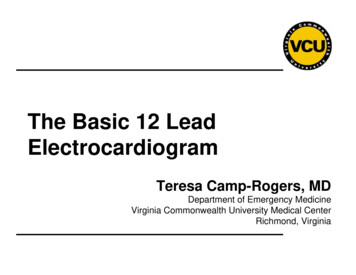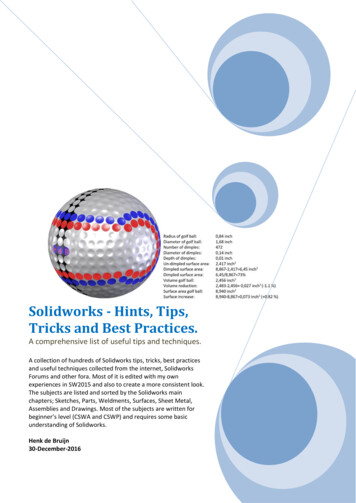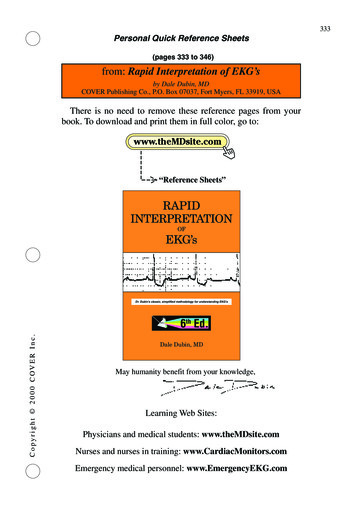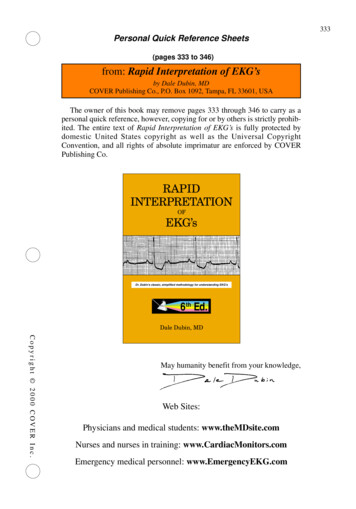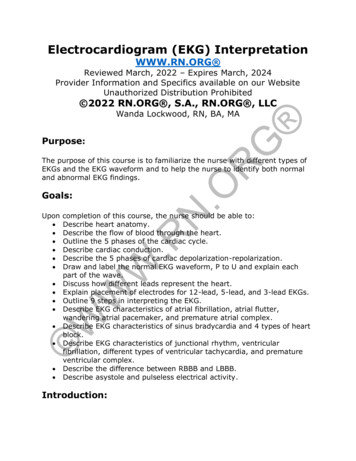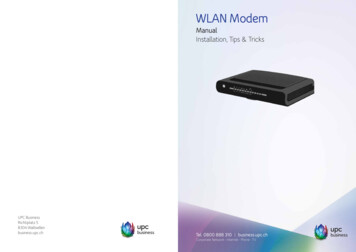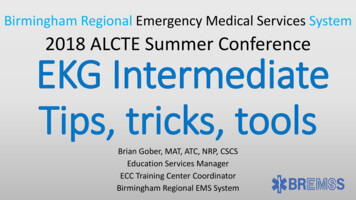
Transcription
Birmingham Regional Emergency Medical Services System2018 ALCTE Summer ConferenceEKG IntermediateTips, tricks, toolsBrian Gober, MAT, ATC, NRP, CSCSEducation Services ManagerECC Training Center CoordinatorBirmingham Regional EMS System
Birmingham Regional EMS SystemAddress:1114 16th Street SouthBirmingham, AL y-Friday8:00 am - 5:00 pm
Birmingham Regional EMS SystemReal-time EMS serving Blount, Chilton, Jefferson,Shelby, St. Clair, Walker, & Winston counties inNorth Central Alabama. BREMSS’s main goal is toserve all providers of emergency care in the regionso patient life & limb are saved, to lead with visionthe EMSS of the region in development &implementation of a system that delivers patientcare at the highest level, to educate the communityabout emergency medical care, & continue theeducation of healthcare personnel in the newestlifesaving knowledge, techniques, & skills.
Objectives Explain each step in the EKG interpretation process. Using the rules of ECG Interpretation, identify sinus rhythms. Using the rules of ECG Interpretation, identify atrial rhythms. Using the rules of ECG Interpretation, identify junctional rhythms. Using the rules of ECG Interpretation, identify ventricular rhythms. Using the rules of ECG Interpretation, identify heart blocks. Using the rules of ECG Interpretation, identify cardiac arrest rhythms. Explain 12 lead EKG Interpretation.
# 1 Problem Students Have withEKG Interpretation?
Memorization vs. Interpretation
EKG Waveforms
Rules of EKG Interpretation5 Basic Steps Rate Is it Regular or Irregular? Is there a P wave Present? What is my PR Interval? How wide is my QRS complex?
Inherent Cardiac RatesThe frequency of impulseformation attributed to a givenpacemaker location within theheart.- sinus node, 60 to 100beats/min- atrioventricular junction, 40 to60beats/min- ventricle, 15 to 40 beats/min.
Rate: 6 Second MethodThe second method can be used with an irregular rhythm to estimatethe rate. Count the number of R waves in a 6 second strip and multiplyby 10
Rate: 300 ruleThe square counting method is ideal for regular heart rates. Use thesequence 300-150-100-75-60-50-43-37. Count from the first QRScomplex, the first thick line is 300, the next thick line 150 etc. Count thenumber of QRS complexes that fit into 3 seconds
Rate: ECG Rate Ruler
RegularityDetermining regularity is the second step of analyzing an ECG rhythm.Irregular rhythms are considered abnormal and can be caused by avariety of conditions. If the distance of the R-R intervals or P-P intervalsis the same, the rhythm is regular – if the distance differs, the rhythm isirregular.
Regularity: Calipers
P Waves Are they present? Upright or Inverted? The P Wave represents Atrial Depolarization. Absence of a P wave indicates that there is no conduction witin theatria Absent or inverted P Waves with an associated narrow QRS complexmay indicate a Junctional origin
PR IntervalIn electrocardiography, the PRinterval is the period, measured inmilliseconds, that extends from thebeginning of the P wave (the onsetof atrial depolarization) until thebeginning of the QRS complex (theonset of ventricular depolarization);it is normally between 120and 200ms in duration.
Abnormal PR Interval
QRS DurationThe normal duration (interval) of the QRScomplex is between 0.08 and 0.10seconds — that is, 80 and 100 milliseconds.When the duration is between 0.10 and0.12seconds, it is intermediate or slightlyprolonged. A QRS duration of greaterthan 0.12 seconds is considered abnormal.
Terminology Sinus: Originates from the SA Node Atrial: Originates from the Atria but not specifically the SA Node Junctional: Originates in and around the AV Junction Ventricular: Originates in the Ventricles Asystole: No Electrical Activity Tachycardia: Fast Heart Rate Bradycardia: Slow Heart Rate Supraventricular: Above the Ventricles
Sinus Rhythms Normal Sinus Rhythm Sinus Bradycardia Sinus Tachycardia Sinus Arrhythmia
Atrial Rhythms Atrial Tachycardia Atrial Flutter Atrial Fibrillation Prematura Atrial Contraction
Atrial Tachycardia
Atrial Flutter
Atrial Fibrillation
Premature Atrial Contraction (PAC)
Junctional Rhythms Junctional Escape Accelerated Junctional Junctional Tachycardia Premature JunctionalContraction
Junctional Escape
Accelerated Junctional
Junctional Tachycardia
Premature Junctional Contraction (PJC)
Ventricular Rhythms Ventricular Tachycardia Ventricular Fibrilation Idioventricular Rhythm Accelerated IdioventricularRhythm Polymorphic VentricularTachycardia (Torsades dePointes) Premature VentricularContraction
Ventricular Tachycardia
Ventricular Fibrillation
Idioventricular Rhythm
Accelerated Idioventricular Rhythm
Polymorphic Ventricular Tachycardia(Torsades de Pointes)
Premature Ventricular Contraction (PVC)
Heart Blocks 1st Degree AV Block 2nd Degree AV Block Type I 2nd Degree AV Block Type II 3rd Degree AV Block
st1Degree AV Block
nd2Degree AV Block Type 1 (Wenkebach)
nd2Degree AV Block Type 2 (Classical)
rd3Degree AV Block (Complete Heart Block)
Asystole
12 Lead EKG
Rules of EKG Interpretation5 Basic Steps Rate Is it Regular or Irregular? Is there a P wave Present? What is my PR Interval? How wide is my QRS complex?
Brian Gober, MAT, ATC, NRP, CSCSEducation CoordinatorECC Training Center Coordinator(205) 934-2595 Extension 3(205) 790-7613bcg@uab.edu
Using the rules of ECG Interpretation, identify junctional rhythms. Using the rules of ECG Interpretation, identify ventricular rhythms. Using the rules of ECG Interpretation, identify heart blocks. Using the rules of ECG Interpretation, identify cardiac arrest rhythm
